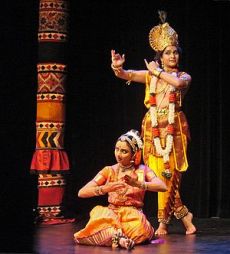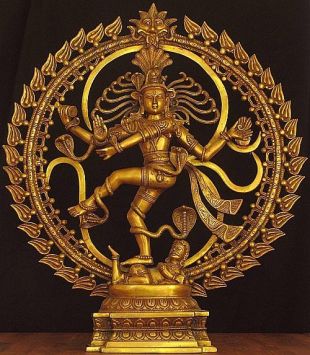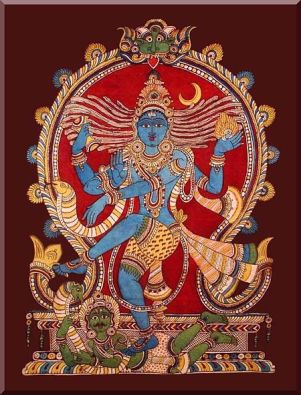Lakshana Granthas – continued
2. Tamil Traditions

The ancient Tamil classics , such as Silappadikaram (dated around the second century) attributed to Prince Ilango Adigal; and the Manimekalai composed by the Poet Chithalai Chathanar (around the fifth century) have abundant references to Dance. The Silappadikaram also refers to another text on Dance: Jayantam, which prescribed the rules for the dance. These were said to be part of the Tamil Art traditions, the Muthamizh.
There are two existing commentaries on Silappadikaram; one of which is ancient – the Arumpadavuri; and the other is from the fifteenth century by Adiyarkunallar.
The Silappadikaram mentions many technical terms related to Dance. Some of those terms are similar to the ones that figure in the Natyashastra; such as: Natya, Ranga (Arangam, Aadukalam), Pindi, Karana and Mandala (Mandila) etc. There are also many Tamil technical terms; such as: elir kai, tolir kai, arangu, izzippu and such others.
And many concepts and techniques of the Natyashastra are adopted into the Tamil texts. For instance; Nilai, meaning stance, are the six Sthanas as in the Natyashastra; and, Padam the feet variations and the sixteen Angakriyas are also the same.
In its Third Chapter Arangetrakadai, the Silappadikaram mentions how a dancer should have mastery in ‘Pindiyum Pinayalum Ezhirkaiyum Tozhirkaiyum’. Dr. Padma Subrahmanyam explains how these are related to the terms in Bharata’s Natyashastra: ‘Pindi’ denotes group dance; ‘Pinayal’ means chain-formation, i.e., the dance where dancers form links; ‘Ezhir kai’ meant Nrtta hastas; and, ‘Tozhir kai’ meant Abhinaya hasta.
The scholars regard Silappadikaram as a Lakshya- Grantha, a text for practice of dance, based on Natyashastra, a Lakshana Grantha, a text which provides theoretical principles.
[ Shri V R Ramachandra Dikshitar in his Silappadikaram (Humpry Milford , Oxford University Press, 1939) mentions on page 65: the general descriptions of Dancing and Music, and the dance of Madhavi , in particular, before the Cola king; and the very names Madavi, Cirapati and Madari , lead us to infer that the author is influenced by Aryan ideas. ]
Silappadikaram refers to the contemporary streams of classical and folk dances. The Dance was known as Aadal or Arangetru Kadai; but more popularly as Kuttu. The folk dances were known as Archiyar Kuravai-kuttu. And Music was: Kadaladu Kadai, Konalvari and Venir Kadai. The folk- Kuttu tradition flourished under the patronage of temples. And, even today the Teukuttu dance troupes perform mythological dance dramas during festivals.
The text also explains the classification of two distinct dance types, prevalent in that era, the Aham (Ahakuttu) and Puram (Purakuttu).
Under the Ahakuttu, twin concepts are explained; such as, Aryam and Tamil; and Lyalpu and Desi.
Further Santi Kuttu, representing classical form of dance was divided into four types, namely Chokkam; Mey kuttu; Avinaya kuttu and Natakam. Of these, the Chokkam or Suddha Nrttam (pure dance, Nrtta) was having the 108 Karanas.
The other was Vinoda Kuttu or Metu Kuttu (also called Ahamargam) for entertainment, depicting love themes. It was of three kinds, viz., Desi, Vadagu and Singalam.
It again had three divisions – Sama Kuttu, Vanmai Kuttu (Tandava) and Menmai Kuttu (Lasya).
Under the other category, Purakuttu, three modes of dances were mentioned as: Perunatai, Charyay, and Bhramari.
*
As regards the Dancers, apart from the Devadasis-the temple dancers – the Silappadikaram mentions other classes of female dancers. It appears during the time of the Silappadikaram a three-fold classification of female dancers existed as: ganikas, kuttis and adal siladi – corresponding to the later classification tahyilar, patiyilar and devaradiyal.
The text, in that connection, names these other classes of dancers as: kaval ganika (women guards); kalattiladum kutti (dancers in the military camp); adal kuttis (dancers who performed ahakkuttu or srngara dances like padams), and so on.
Women musicians and dancers were known in the Tamil country from the Sangam Age. The daughter of the Chola King, Karikal Chola, Adi Mandi was an acclaimed dancer. She danced with bells around her waist to the sweet sound of the golden symbols, a kind of musical instrument. The Sangam literature refers to Panar and Viraliyar, the musicians and dancers. Both formed into a troupe and travelled together to perform in front of patrons. They played on the Yal (a kind of lute); Maddala, Kudamula (drums); and, on the Amantirikai i.e., Edakkai, all of which blended in unison beautifully.
In one of the verses in Ahananuru, the dance of the girl Virali is compared to the movement of the peacock with spread out plumes.

Madhavi, the most beautiful accomplished dancer by profession (Parathiyar), described as Vanavamakal (divine woman), is one of the three leading ladies in the Silappadikaram.
It is said; Madhavi’s training began when she was a young girl of just five years; and, it lasted rigorously for seven years
From the early age of five, for seven years, Madhavi had been put through a course of rigorous training. Every single day her teachers would arrive in Morning and evening; and, she sang scales and practiced dance movements. More masters came. She learnt to accompany herself on the Yal. She learnt the fine points of the flute and drum. Later still, came the composers, insisting that she should bring out all possible shades of meaning from every song she sang or danced to. And, till the day of her first performance she kept practicing, rehearsing strenuously and planning out every detail.
Madhavi was described in the ‘Ararigetru kaathai’ Chapter of Silappadikaram, as a woman (matantai), having broad shoulders (perun tol) and curly hair (puri kuzhal) adorned with pollen (taatu avizh) of flowers. Madhavi studied dancing (aatal), paatal (singing) and the art of enhancing beauty (azhaku). She was capable of singing without even one (onru) defect (kurai) in three (muunru) modes (kuur) ; and, was an authority (pataam) in her field. She studied these skills with great effort (iyatti) for seven years (eezh aantu). After twelve (eer aaru) years (antu), she wished to show (kaattal) her performance before the king (mannar) of Pukar, who has the surrounding (chuul) sea (katal) as the boundary of his kingdom.

And Madhavi’s Arangetram (Talai Arangerai) took place in the presence of the Chola King Karikala Peruvalathin, in his Royal court, located in the famous city of Kaveri poom-pattinam.
[Shri T. S Parthasarathy, in his article Bharathanatyam in History, writes: Arangetram was called Talai Arangeral. As soon as the dancer got on to the stage two songs were sung and they were called daiva-padal or prayer. After this, all the instruments on the stage were played together; and, this was called as Antarak-kottu. The dance started after this; and, the girl first danced desi-koothu. This would start with Matta-talam and end with Eka-talam. The next item was Margam for which a Prabandham was sung in the Pancha-talam]
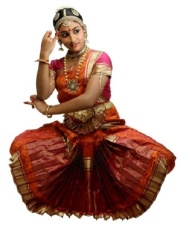
The Chapter Arangerrukadai (on page 97) opens with a description of Madhavi and then her troupe, consisting of a very learned Natyacharya or Nattuvan (Adal Asiriyan), a Sangitacharya or musician (Isai Asiriyan), the player on the drum (Tannumai Asiriyan), and an accompanying orchestra of a flutist and a lute-player (Kuzhalon and Yal Asiriyan).
The Chapter on dance, Arangerrukadai, elucidates, in great detail, the proficiency of the dance teacher and his skill as a choreographer and musician, and tie principles of stage management.
This chapter also gives a detailed account of the rules and principles pertaining to the dance music i.e. vocal as well as instrumental dance musical accompaniments. The importance of the proper instrumentation i.e., tuning and playing of different instruments such as Yal, flute and drum and the manner in which the combination of these instruments should exist and be executed which ultimately facilitate in heightening the aesthetic pleasure of the dance have been mentioned in elaborate measure.
In addition to this, Silappadikaram states the qualifications of a good dance teacher, known as ‘Adal asiriyan’, vocalist and other members of the orchestral troupe.
As regards the dance teacher, it mentions that the adal asiriyan should be proficient not only in the eleven types of dances, but also should be well versed in its music ; and, must have thorough knowledge in the allied arts such as music, literature and should be capable of playing on different musical instruments too.
It is said; the Dance-Master knew the characteristics of the two Schools of Dancing art (Kuttu) – Desi and Marga. He could effectively combine the different dancing poses with the Vilakku song, such as Venduvilakka, Pataivilakku ,Urvilakku and others. He had the clear knowledge of the eleven modes of body-movements and limb-movements (Aadal) ; of the songs (Pattu) ; of resounding instruments (Kottu) ; as also of the dance (Adal) of gestures (Padal) ; of the measured beats (Pani); and, of the time-beats (Takku).
He knew when only one hand had to be used for gestures (Pindi) ; and , when both the hands had to be used (Pinaiyal). He knew when the hands had to be used for indicating action (Tolirkai) ; and, for expressing graceful movements (Elirkai). In the movements of the feet , he did not mix up the Kuravai-kuttu with Vari-kuttu. He was such an expert Dance-Master.
Madhavi’s Music teacher who played , in the like manner, was an adept in his field of art; and in playing on the four varieties of Yal (string instruments – Periyal, Makarayal, Sakotayal and Sengottiyal , of 21, 19, 14 and 7 strings , respectively); and on Kulul (flute). He was also well versed in the techniques of keeping time-units (Taalam) and in the production of soft notes on the Mrdangam. He could harmoniously synchronize all those sounds with the Vari and the dancing (Aadal). He had the flawless knowledge of Desikam music.
As regards the composer of songs, he was very well learned in Tamil language. He was an acknowledged expert in Dramaturgy; and, was well versed in the two branches of dramatic compositions – Vettiyal (relating to Aham) and Poduviyal (relating to Puram).
The Mrdangam player knew very well how to accompany various modes of rendering of speech, songs and different situations . In maintaining the appropriate Taalam , he knew how to combine beats of varied speeds ; and, to melodiously merge with the notes of the lute, flute as also with the evenly drawn out notes of the vocal rendering. With dexterity, he could, whenever necessary, subdue the sound of his playing , so that other instruments and the singing could be properly heard.
The flute-player was a master in the traditional rules of his art. He knew the combinations of the Cittira-punarappu (hard consonants in rendering a song) and the Vanjanai –punarappu (soft consonants in singing) , whereby harsh syllables could be rendered soft and sweet. He knew four types of Vartanam (finger-skills) . And, with his knowledge of the Palai music (Kural and Ili) , he adjusted the sound of the flute with the sounds of the Mulavu and to the beats of the Mrdangam . At the same time, he followed the notes voiced by the singer ; and, elaborated upon it.
Then there was the player on the lute of fourteen strings (Sakotayai) . In order to play the seven Palai notes, he would tune the strings of the lute , such as the Taram and the Kural; and, bring them to the central part of the lute; and then tune the Kaikkilai part of the instrument. Similarly, he would tune the two other softer strings of the instruments on the Kural side; bring them also to the central part of the lute; and, tune the Vilari part of the instrument.
Thereafter , starting with the Ulai, the most slender string , and proceeding up to the Kaikkilai, he would play on all the fourteen strings producing Samapalai notes, in a definite order.

After describing the qualities of these accompaniments, the poem describes the stage on which Madhavi gave her performance.
The debut of Madhavi is said to have commenced by rendering the innovatory songs called the ‘Varam’ or ‘Tevara padal’ collectively sung by a group of songsters including the old dancers.
After the rendering of the Antarakkottu involving two kinds of Varams, the four parts of the auspicious Palaippan was sung with precision ; beginning with three Mandilams and ending with a Ottu (eka-talam).
Madhavi, of long, black-flower-like eyes, adorned with rich ornaments, performed Cittira Karanam (perhaps similar to the Purvaranga or invocation, as mentioned in Natyashastra).
She performed , as explained by Sri Santanam Swaminathan , as many as eleven types of Kuttus or dances (Mandalas – combination of 8-10 Caris), in all the tempos, in accordance with the dancing conventions; and thus, completing Antarakottu.
-
- Alliam: This is a dance about Lord Krishna’s victory over the mad elephant.
- Kodukotti : This is the dance Lord Shiva performed after burning the triple cities of Asuras/demons
- Kudai: This is about Lord Skanda’s victory over the demons
- Kudam : Kannan performed this after winning the release of his grandson Anirudh from the prison of Banasura.
- Pandarangam: Brahma was entertained by Shiva with this dance after Shiva’s win over the Triple Cities of demons.
- Mal: This describes the wrestling contest between Bana and Lord Krishna
- Thudi : This is Skanda’s dance after defeating the demon Suran
- Kadayam : This is the dance performed by Indrani at the north gate of palace of Banasura.
- Pedu : Manmathan’s dance dressed as a eunuch to secure the release of his son Anirudh.
- Marakkal: When demons sent poisonous creatures like snakes and scorpions against Goddess Durga she danced with stints (Stick dance). This is known as Marakkal literally “wooden legs”.
- Pavai : Goddess Lakshmi’s dance against the warring demons.
And, then she demonstrated all the four parts of the auspicious Palai song, displayed in the Desi dance. She began with the Mandalam having three beats; and ended with ‘Eka talam‘ having one beat. In the same manner, she danced the Vaduhu dance. Madhavi, in her performance, effortlessly followed the prescriptions of the Dance-scriptures.
Her performance revealed that she knew (purintu) all the divisions (vakut) of Nrtta and Nrtya (naattiya nannuul); and, the authentic text on dancing (Natyashastra).
It is believed; unlike the present day practice, where the dancer enacts different characters by wearing same costume (Ekaharya), Madhavi is said to have adorned different costumes, suggestive of the character portrayed by her in all the eleven dances.
The fawn eyed Madhavi, strikingly beautiful with perfect features, lit with vivacity and laughter, in her quick movements dazzled like a golden creeper (pon iyal) throbbing with vitality, adorned with flowers (puun koti).
The king (ventan) awarded her with a garland of leaves and flowers (ilai puun kotai), in accordance with (vazham ait) the established custom (iyalp-p-inil). He also rewarded her with one thousand and eight (aayirattu en) Kazhanchu (pieces of pure Gold) as per the tradition (viti murai). She was awarded the title of Talaik-koli, in recognition of her skill and her achievement. She was also presented with the sacred-staff Talai-kol, a traditional gift given to first-time-performers (talai-arangu-eri).

[As regards Talai-kol, it was a sort of staff wielded by the dance-master to regulate the dance. It was conceived as a symbol of Indra’s son. It was crafted out of the handle (kaampu) of a white umbrella (ven kutai) that belonged to noble person (per icai) or a king (mannar) or a great sage (periyar).
Its middle (itai nilam) was decorated with the best Navalam; covered with plates of purest jambunada gold (polam} ; and, adorned with nine kinds of gems (nava Mani), studded (ozhukki) in its joints (kan itai), forming a beautiful pattern. It had an emblem of Jayanta (cayantan}, the son (ciruvan) of Indra (Intira). The finished rod was offered worship (vantanai) in the palace (koyil) of the Chola king (mannavan), who sits under a white Umbrella (ven kutai).

On an auspicious day (nalam taru naal), Madhavi washed (manni) the rod (kol) with holy waters of the Cauvery (punniya nan neer) in a golden pot (por kutam) and adorned (anintu) it with a garland (malai) . It was then publicly (paracinar) placed on the head (tatakkai) of the sixty year old royal-elephant (aracu-uvaa), along with a beautiful (puun) golden (polam) vessel (otai) containing sandal (Cantaṉam) and other auspicious things.]

[ After winning the very prestigious award and gaining widespread fame, Madhavi’s life takes a bizarre turn:
The large lotus-eyed Madhavi gave the garland , which was presented to her by the king, to her hunch- backed maid, instructing her to stand out in the street where the rich citizens of the city moved about; and, to announce that ‘this garland is worth a sum of 1008 kalanjus of very excellent gold (jambunada) . He who buys this garland becomes the husband of our Lady, glowing like a lustrous golden creeper ’.
The garland was purchased by Kovalan, a wealthy merchant hailing from the city of Kaveripattinam. And, thereafter, accompanied by the hunchback, he entered Madhavi’s bridal chamber; and, was so much captivated by her charms as he forgot himself and took an oath that he would never ever be away from this divine looking damsel. In sooth, he forgot his own unsullied home and wife, Kannagi.
The Love struck Kovalan married Madhavi; and, the couple thereafter lived happily for about three or more years. A lovely looking daughter Manimekhalai was born to them. During the intervening period many weird and disturbing incidents take place; following which, Kovalan, in a huff, walks away from Madhavi and returns forever to his earlier wife Kannagi.
Thereafter, Madhavi gifts away her wealth and other possessions; renounces the worldly life; and, enters into the Buddhist Sangha as a nun.
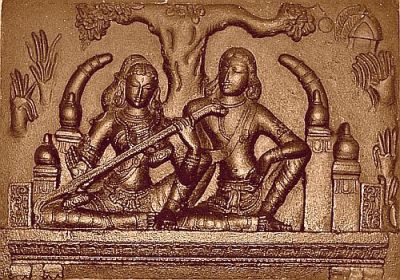
In another epic Manimekhalai, of the later Sangam age , composed by the Buddhist poet Seethalai Sattanar or Chithalai Satthanar (2nd Century CE), the lovely daughter of Madhavi and Kovalan – Manimekhalai – is the principal character. Like her mother, Manimekhalai is also an accomplished dancer and a courtesan. Later, upon hearing doctrinal expositions from the Buddhist teacher Bhikshu Aravana Adigal, she enters the Sangha and becomes a Bhikshuni or Buddhist nun; and, dedicates the rest of her life to Dharma.
[ please also read : Manimekalai the Dancer with Magic Bowl – The Second Century Tamil Epic Legend by Arputharani Sengupta
Manimekalai knew how to play the harp (yal) tuned according to the various moods. She was accomplished like her mother Madhavi, who knew both kinds of dance, dances suitable for the royal palace and those for the common public, poems set to music, the art of dramatic posture (tukku) to emphasise the rhythm of the poetic meter, the various musical rhythm (tala) (fig.12). She knew by heart the poems chanted during the dances and had mastered the language of gesture (mudra), by which love (akam), virtue and glory (puram) are expressed She knew how to play the great drum and how to adjust the tightness of its skin to regulate the sound. She knew how to play the melodious flute, as also the art of playing the ball, of preparing dishes according to recipes of the best cuisine as well as the preparation of scented powders of diverse colours, the manner of bathing in various seasons, the body‘s sixty four positions in making love, the art of anticipating men‘s desires, of speaking charmingly, of writing elegantly with cut reed, of arranging magnificent bouquets of flowers for their form and colour, the choice of dress and jewels according to circumstances and the art of fashioning necklaces of precious pearls or precious stones. She had also studied astrology and the art of measuring time, and other similar sciences, the art of drawing and painting all of which, according to the book’s forms part of the métier of an accomplished courtesan. Living in the street where courtesans resided in several storey high houses with gilded balconies, Manimekalai was destined by birth to enjoy the arts and all the pleasures of life.
Although endowed with great beauty and accomplished in the arts, to the amazement and distress of her mother and companions, Manimekalai left home to dedicate her life to charity and to attain the bright light of knowledge.
It is said; Manimekalai, the Dancer with the Magic Bowl, also received the gift of a magic bowl that produced perennial quantities of food to feed the destitute. Besides salvation to mankind, Manimekalai could bring solace to her parents Madhavi and Kovalan..]
***


The most beautiful, golden-hearted Manimekalai, causes to build a delightful garden in the graceful city of Kanchi, in honour of the Buddha; places the Amuda Surabhi at the lotus seat of the Buddha ; and, welcomes all living beings, including the lonely, the neglected, the hungry, the defeated, and the maimed to gather and partake food offered by her and bless her.
Even though Manimekalai was a Buddhist, she went to Jain monks at Vengi, the Chera capital; and, learnt about the Jain concepts of morality (Manimekalai 27:167-201).
It is said; Manimekhalai ardently practiced the Buddha’s teachings and attained the highest stage of Buddhist spiritual attainment, an Arhant.

[ I acknowledge with thanks this creation by the artist Smt. Lalitha Thyagarajan ]
References and Sources
- http://shodhganga.inflibnet.ac.in/bitstream/10603/71949/8/08_chapter%203.pdf
- https://joss.tcnj.edu/wp-content/uploads/sites/176/2017/04/2017Ruhl.pdf
- https://www.scribd.com/document/234378951/Arangetram-History
- http://shodhganga.inflibnet.ac.in/bitstream/10603/71949/8/08_chapter%203.pdf
- http://www.yabaluri.org/Web%20(1978%20%-202008)/theatrearchitectureinancientindiaoct98.htm

3.Agni Purana
Agni Purana is one of the eighteen Puranas. It usually figures eighth in the list of eighteen. It is a medieval Purana that was, perhaps, compiled in stages during the Seventh and the Eleventh centuries. It is a voluminous work having as many as about 15, 000 or more verses , spread over 382 or 385 Chapters.
In its nature and content, the Agni Purana is a sort of an encyclopedia that covers ‘anything and everything’. It deals with wide-ranging subjects, such as: geography; cultural history; politics; education system; iconography; taxation theories; organization of army; theories on proper causes for war; diplomacy; local laws; building public projects; water distribution methods; trees and plants; medicine, Vastu Shastra (architecture); gemology; language; grammar; poetry; Alamkara, Chhandas; Rasa ; Riti; Yoga; food,; rituals and numerous other topics.
Just to gain a familiarity with the coverage of the Agni Purana, please click on HERE and on HERE.
The initial Chapters of the Agni Purana describe about various incarnations of Lord, including Rama and Krishna. Other chapters describe about religious rituals especially those related to the worship of Lord Shiva. Many chapters have description about the earth, stars and constellations as well as the duties of the kings. The Agni Purana, generally, is full of rituals
All this leads to the fact the Agni Purana was composed at a much later period , attempting to bring together , in a summary form, the stories, the rituals, and the details of various subjects that were described in the earlier Epics and the Puranas.
Therefore, none of the material in the Agni Purana is new or original. Its aim, perhaps, was to supplement the branches of traditional knowledge contained in the earlier texts; and, to collect and to preserve the core-topics of the important subjects, which were of current interest during the period of its compilation.
Thus, the Agni Purana, by its very nature is a summary. Therefore, its chapters are generally not long, they are very brief. And even when the stories, rituals and other information are given, they are in greatly summarized form.
Following that type of presentation, the Agni Purana, in its Chapters 340 and 34i , gives some information about Dance, particularly relating to Anga-karma Abhinaya (actions, gestures and movements) , largely taken from the ancient Nrttasutra and the Natyashastra.
[Please click HERE for the text of the Agni Purana; and, refer to the portion commencing with the title Nṛtyādāv-aṅga-karma-nirūpaṇaṃ; and, here for Abhinayādi-nirūpaṇaṃ ]
In Chapter 340 (Aṅga-karma-nirūpaṇaṃ) , the Agni Purana mentions the actions of the Angas and Pratyangas; thirteen actions of head (Shirobedha); which are the same as given In the Natyashastra.
Thirty-six movements of eyes (Dṛṣṭī-lakṣaṇam) are mentioned, among which, eight are the Rasa-drstis, related to the expressions of the various emotions and sentiments.
The Purana refers to nine actions of the eyeballs (Tara) (as compared to eight by the Natyashastra); but mentions by name only the two – Bhramari and Calana.
Agni Purana mentions just four types of actions of the eyebrows (Bhru) – (Patana, Bhrukutimukha, Sthayi and Sanchari). However, the last two were not included among the seven types of eyebrow movements enumerated in the Natyashastra.
Agni Purana refers to six different actions of the nose (Nasika), without enumerating them by name. The Purana refers to nine actions of respiration (Nisvasa) . But, these were not mentioned In the Natyashastra.
The Purana refers to six actions of the lower lips (Adhara); seven actions of the chin (Cibuca); six actions of the face (Mukha); and, nine actions of the neck (Griva) ; without , however , naming them .
The Agni Purana also refers to there are various actions of the hands (Hasthas) – single and combined (Asamykuta and Samyukta). It mentions the twenty-four Asamyukta-hasthas in the same order, with slight variation, as mentioned in the Natyashastra. As regards the Samyukta-hasthas, they are twelve in number (not thirteen as in Natyashastra). The Pushpaputa is omitted here.
[Similarly, the other Puranas, such as , the Vishnu Purana, the Bhagavata Purana and the Harivamsha provide some general information of the Hastas.]
The Purana also refers to five actions of the chest (Urah) ; five actions of the sides (Parsva) ; and, to five actions of the thighs (Uru) . But, these are neither specifically named nor discussed.
Agni Purana names the three actions of the belly (Udara) as: Duratiksama, Khanda and Purna. The first one is mentioned in the Natyashastra, merely, as Ksama.
The movements of the feet (Pada-bedha) are mentioned as being various; but without mentioning their specific numbers.
*
Thus, the Nrtyadi-ranga-karma, information about the bodily actions in Dance, is very brief. And, in certain cases, it slightly differs from the Natyashastra. Obviously, the Agni Purana obtained its information about Dance from another source also; perhaps from Nrtta-sutra, which is no longer extant.
*
The Agni Purana , in its Chapter 341, describes the importance of the four types of Abhinayas ; and , remarks that the four factors viz., Sattva, Vac, Anga and Aharya play a dominant role in bringing out the best that exists in a dramatic composition and In the heart of the dramatic personae.
Ābhimukhyan nayann arthān vijñeyo a’bhinayo budhaiḥ / caturdhā sambhavaḥ sattva vāg aṅgā aharaṇ rāśrayaḥ //AP_341.001//
stambhādiḥ sāttviko vāgārambho vācika āṅgikaḥ / śarīrārambha āhāryo buddhyārambhapravṛttayaḥ // AP_341.002//

References and Sources
- http://shodhganga.inflibnet.ac.in/bitstream/10603/164285/8/07_chapter%202.pdf
- https://www.kamakoti.org/kamakoti/agni/bookindex.php
- http://www.bharatadesam.com/spiritual/agni_purana.php
- http://www.aa.tufs.ac.jp/~tjun/data/gicas/ap3_tr_frame.html
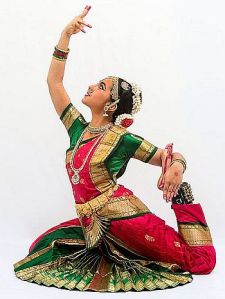
- Vishnudharmottara
The Visnudharmottara Purana (Ca. fifth or sixth century) is a text that is Encyclopedic in its nature. Apart from painting, image-making, Dancing and dramaturgy, it also deals with varied subjects such as astronomy, astrology, politics, war strategies, treatment of diseases etc.
The author asserts that the Vishnudharmottara is but a compilation; and, is an attempt to preserve the knowledge that was hidden in older sources. Sadly, all those older texts are lost to us. Vishnudharmottara is thus the earliest exhaustive treatise available to us on the theory and practice of temple construction, painting, Dancing and image making in ancient India.
The text, which is divided into three khandas (parts), has in all 570 Adhyayas (chapters). It deals with dance, in its third segment – chapters Twenty to Thirty-four.
The author follows the Natyashastra in describing the abstract dance form, Nrtta; and, in defining its function as one of beautifying a dramatic presentation. There are, however, slight variations in the enumeration of the Karanas, Angaharas and Hastas.
The focus of the text is on Nrtta, defining its vital elements such as Karanas, Cari etc., required in dancing. In addition, the author briefly touches upon the Pindibandhas or group dances mentioned by Bharata; and, goes on to describe Vrtti, Pravrtti and Siddhi; that is – the style, the means of application and the nature of competence.

As regards its structure and the contents of the Parts dealing with Dance:
:- In Chapter Twenty (the first chapter of the section), the author follows the Natyashastra in describing the abstract dance form, Nrtta; and, in defining its function as one of factors beautifying a dramatic presentation.
The Chapter Twenty deals with the appropriate places for the performance of Nrtta. It also discusses the aspects of the stage and the presentation of the preliminaries. The discussion includes the characteristics of actors; the four different types of Abhinayas, namely – Angika, Vacika, Sattvika and Aharya; and the names of all the complicated movements necessary for the composition of a dance sequence. In addition, the author briefly touches upon the Pindibandhas or group dances mentioned by Bharata; and goes on to describe Vrtti, Pravrtti and Siddhi, ; that is – the style, the means of application and the nature of competence.
:- The Twenty-first Chapter discusses Sthanas or postures while lying down (Shayana);,while the Twenty-second deals with the Sthanas to be assumed by persons of different status , while sitting. The focus of these two chapters seems to be on dramatic presentation.
:- The twenty-third chapter is devoted to postures meant for both men and women.
:- The Twenty-fourth Chapter lists the movements of the major limbs, the Angas, along with the meaning attached to each of those movements. The major limbs, according to this text, are the head, the neck, the chest, the sides, the waist, the thighs, the shanks and the feet. In conclusion, the Chapter defines the Cari and the Karana, the two vital and complicated movements required in Dancing.
:- In the Twenty-fifth Chapter, the movements of the Upangas or minor limbs are discussed, including the glances of the eyes (Dristi bedha) that express the Sthayi and Vyabhicari- bhavas; the movements of the pupils; the eyebrows; the nose (nostrils), chin and lips, as well as the application of these movements.
:- The Twenty-sixth chapter describes three types of hand-gestures (Hasthas), those made with one hand (Asamyukta), those made with both (Samyukta) – along with the meanings they can convey – and hand-gestures meant for dancing (Abhinaya), which convey no meaning (Nrtta-hastha).
:- The twenty-seventh chapter is devoted to the explanation of different kinds of Abhinaya and the costumes and decorations (Aharya) necessary for a performance.
:- The twenty-eighth chapter deals with Samanya-abhinaya, giving general directions for expressing different moods and responses to seeing, touching and smelling objects. Although the author designates this chapter as a discussion of Samanya-abhinaya, he includes Citra-abhinaya, that is, special presentations. In fact, this Chapter is a conflation of the contents of Chapters twenty-two and twenty-five of the Natyashastra; and, contains extensive quotations from it.
:- The Twenty-ninth chapter describes the Gatis, that is, gaits; while the Thirtieth discusses the nine Rasas; and the Thirty-first Chapter discusses the Bhavas.
A new feature of the treatment of body movements that is added to the discussion of body movements appears in the Thirty-second Chapter, which deals with what is termed Rahasya-mudras, that is, hand-gestures meant for mystical and ritualistic purposes.
:- Continuing the discussion in the Thirty-third Chapter, the author lists more Mudras all meant for religious purposes, and calls them Mudra-hastas, and associates them with hymns to the gods and goddesses.
:- The Thirty-fourth and the final Chapter on dancing is devoted to the legend of the origin of dancing. Since the work is devoted to the worship of Vishnu, it is not surprising that its author should view Vishnu as the originator of the art of dancing.

The Vishnudharmottara is Vasihnava text, affiliated to the Pancharatra Agama, which is associated with the Vyuha doctrine. Here, Adi-Vishnu or Para–Vasudeva represents the Pancharatra ideology of the transcendental form (Para) of Vishnu the Supreme principle abiding in the highest realm Paramapada. Vishnu the Absolute, the Brahman, out of loving- compassion, voluntary assumed bodily forms so that the devotees may gain access to his subtle form.
According to Vishnudharmottara, it was Lord Vishnu who created the sublime Art of Dancing, which represents the three levels of existence in all the three worlds (Trai-lokasya-anukaranam).
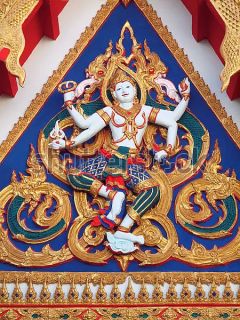

The Nrtta created by Vishnu was composed of Angaharas and Karanas. The text considers Nrtta as the pure, absolute form of Dance; Natya as the depiction of the ways of the world (jagato-anukriya); and Nrtya as the factor that lends beauty to Natya- (VDP. 3.20.1)
The text declares that Dancing in the presence of the Lord is the true worship; it is the adoration of the divinity with one’s body, mind and soul. And, performing Dance as a spiritual discipline (Sadhana) is superior to offering flowers (pushpam, naivedyam) etc. It leads the way to liberation. Thus, the Art of Dancing, Nrtta, is regarded as Mangalya, auspicious and sacred devotional submission to Lord Vishnu.(VDP. 3.34 – 25,26,27 )
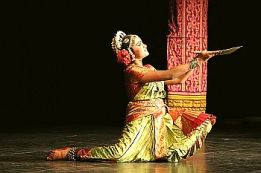
The Vishnudharmottara emphasizes the inter relation, or rather the inter-dependence between the various art forms. Sage Markandeya instructs : One who does not know the laws of painting (Chitra) can never understand the laws of image-making (Shilpa); and, it is difficult to understand the laws of painting (Chitra) without any knowledge of the technique of dancing (Nrtya); and, that, in turn, is difficult to understand without a thorough knowledge of the laws of instrumental music (vadya); But, the laws of instrumental music cannot be learnt without a deep knowledge of the art of vocal music (gana).
Whatever is prescribed for Nrtta is equally applicable to Chitra as both imitate the rhythm or Chhandas or the subtle aspect of the phenomenal world. Movements of eyes, lips and limbs, depiction of Bhava and Rasa (sentiments) and the various Mudra-s (postures), prescribed .for Dance are also followed in Chitra ; and, the same principles govern the practice of these two sets of Fine Arts, one performing and the other synthetic.
The main difference between the Dance and painting is that the former has Tala or Laya; because, it is related to Kaala (Time). And, the latter has Rupa (form) and Mana-Pramana (measures and proportions) ; because, it is related to Dik (Space) .
And between Dance and sculpture, , the human form is the instrument of expression; and, everything in the figure, the face, the hands, the posture of the limbs, the pose and turn of the body, each accessory has to be imbued with an inner meaning. It manifests, on the one hand, the basic idea; and, on the other, suppresses anything which would mean an emphasis on the merely physical or sensuous.

The dance-posture gives each sculpture a rhythm which is its soul or spirit. Because of the fact that the rhythm arising out of dance-postures instils life into its form, the stone-mass seems to breathe and pulsate like a living organism. Dance (Nrtta) endows life to sculpture (Shilpa).
Hence, the Sage Markandeya declared Nrtta and Chitra, to be art-forms par excellence : ta eva chitre vijneya nrittam chitram param matam
Yatha nritte , tatha chitre trailokya-anukritis smrita / drishtayas cha tatha bhava angopangani sarvasah / karas cha ye maya nritte purvokta nripasattama / ta eva chitre vijneya nrittam chitram param matam // 3.35.5-7//

Angikabhinaya
As said earlier; the Vishnudharmottara generally follows the descriptions and technical details as given in the Natyashastra; but, with slight variations. For instance; it describes Tandava as a form of dance that is characterized by intense excitement and ferocious mood; and, it is to be performed by males. And, it describes Lasya as show of amorous expressions and graceful movements of limbs; and, it is performed by women. There also some other minor variations in the enumeration of movements of certain Angas, Pratyanga and Upangas.
It devotes more space to Nrtta and Angikabhinaya. It mentions that the ideal Nrtta is full of Rasa and Bhava. It follows Tala (rhythm), Kavya-rasa (meaning) and Gita (song and lyrics). It gives happiness; and increases the Dharma.
Rasena Bhavena samanvitan ca talanugam kavya rasanugam ca/ gitanugam Nrtta mukati dha Sukhapradam dharma vivardhanam (VDP. 3.20.1)
The Vishnudharmottara devotes three Chapters (24, 25 and 26) of its Third Khanda to discuss, in detail, the various aspects of the Angikabhinaya, which portrays actions; and, also reflects emotions through movement of the various parts of the body.
The Chapter Twenty four enumerates the movements of the major limbs, the Angas, along with the uses of each of those movements. The Chapter defines the Cari and the Karana, the two vital and complicated movements required in Dancing.
In the Twenty-fifth Chapter, the movements of the Upangas or minor limbs are discussed, including the glances of the eyes (Dristi bedha) that express the Sthayi and Vyabhicari- bhavas; the movements of the pupils; the eyebrows; the nose (nostrils), chin and lips, as well as the application of these movements.
The Chapter Twenty-six on the Hasthas (Hastha-adyaya) gives the descriptions of the three types of the arrangement of the Hasthas (Asamyukta, Samyukta and Nrtta-hastas)
As regards the Nrtta-hastas, The Vishnudharmottara emphasised that all the Nrtta hastas should be delicate, beautiful and charming. The main characteristic of Nrtya is Lalitya, delicately graceful.
The sage Markandeya remarks: The learned should make graceful movements of the Nrtta-hasthas; because, it is the grace and beauty that differentiates Nrtta from other movements (VDP. 3.26.95).
Karya lalita sancara nrttahasta para vidhau / lalityameva viterya pratibhodanam (3.26.95)

Pindibandha
There is also a brief description of the Pindi or Pindibandha performed by groups of dancers; which is the technique of group formations, and, weaving patterns. Pindi is described in the Vishnudharmottara as having the shape of the symbol of a particular deity. In the Natyashastra, Bharata mentions several such Pindis; and, says that the Pindis of the presiding gods and goddesses will be marked with their own banners. Thus, the Īśvara piṇḍī is for Īśvara; Siṁhavāhinī for Caṇḍikā; Śikhī piṇḍī for Kumar and so on.

Aharya
The whole of 27th Chapter is devoted to Aharyabhinaya, which deals with costume, ornaments, makeup , stage props etc. The Aharya has to be particularly suited to each type of character; and, has also to be relevant to the situation. The appropriate Aharya for each character is essential for bringing out the dramatic effect; and, often, the entire production depends on it.
The Aharyabhinaya is said to be of four kinds: Pusta; Alamkara; Angarachana; and, Sanjiva.
The Pusta refers to imitative forms made of clay, wood, cloth, leather or metal. These are the masks (Pratisirsani) of gods, demons, Yakshas, elephants, horses and birds, made by use of the Pusta techniques. Pusta might also refer to the background or the props.
The Alamkara is adornment or decoration by means of costumes, garlands and ornaments etc.
The Angarachana (lit. Painting of limbs) is makeup by application of creams, colours, paints etc on the person of the actor.
And, Sanjiva is the use of living creatures, animals and birds.
For the Angarachana, the Vishnudharmottara mentions the rules that should be followed for gods, other beings and humans. These have to be in accordance with the types of masks (Pratikira) and head gears or crests (Makuta or Kirita), beards, moustaches etc., of those characters.
Three kinds of costumes are mentioned: White, Variegated and according to male or female characters, as per the common practice.
The actors should wear the masks of various animals, and, similarly the symbols of various gods carrying their weapons should be represented by masks.
Bharata says that such different modes of dress, makeup and ornamentation should help the actors and actresses to enact their roles in a more credible manner, to bring out the right sentiment of the scene.
As regards colors with which the actors or dancers are to be painted, the Vishnudharmottara mentions five basic colors: white, red, yellow, black and green (blue?). It then enumerates five kinds of white and twelve kinds of black colors. And, by mixing one, two or three colors, with imagination, innumerable skin colors could be derived (VDP.3.27.8-9). It says, when the beauty of the limbs is increased with these colors, the presentation becomes more effective.
That is followed by specifying which characters among the gods, demons, serpents and humans should be painted with which colors. And it says, when no particular color is mentioned for a god, then it should be given Gaura (white) color.
Similarly, the text then specifies the colors of the costumes of different types of characters. It also mentions the various types of head gears, crests, masks, wigs and mustaches etc.
In short, it says, various accessories should be used , with intelligence, in accordance with the customs prevailing in the society.
*
Samanya-abhinaya
The Chapter Twenty-eight is named Samanya-abhinaya. The Samanya-abhinaya is the harmonious use of four kinds of Abhinayas; and, Citra-abhinaya applies only to the special representation of various objects and ideas.
At first, the instructions are given about the representation of five qualities of senses viz. sound (sabda), touch (sparsa), form (rupa), taste (rasa) and smell (gandha) , through gestures according to their experiences (Anubhavas) and natural expressions. Then come the representation of particular objects. The various gestures and expressions are prescribed for the representation of Bhavas including Sthayi-bhavas occurring in different Rasas. The Abhinaya to show sky, morning, night, evening, day, deep darkness, the moon-light, the smoke, the fire and different seasons follow.
*
Abhinaya
Chapters Thirty and Thirty-one give a very detailed description about the Abhinaya of the various Rasas and Bhavas by appropriate gestures. Here, the text discusses nine Rasas, including the Shanta-rasa, as compared to eight Rasas mentioned in the Natyashastra.
It also discusses forty-nine kinds of Bhavas, beginning with Hasa, the mirth; and, they should be skilfully combined with the Rasas.
The forty-nine Bhavas or psychological states, include: the eight Sthāyi-bhavās; thirty-three Vyabhicāri-bhāvās; and, eight Sātvika-bhāvas – (excluding Vibhava and Anubhava).
References and sources
- Shri Vishnudharmottara by Dr. Priyabala Shah
- Arts in the Puranas – Chapter Two- Dance by Dr. Meena Devadatta Jeste
All images are from internet

In the next part we shall move on to other texts dealing with Dance and its several aspects
Continued
In
Part Ten
























































